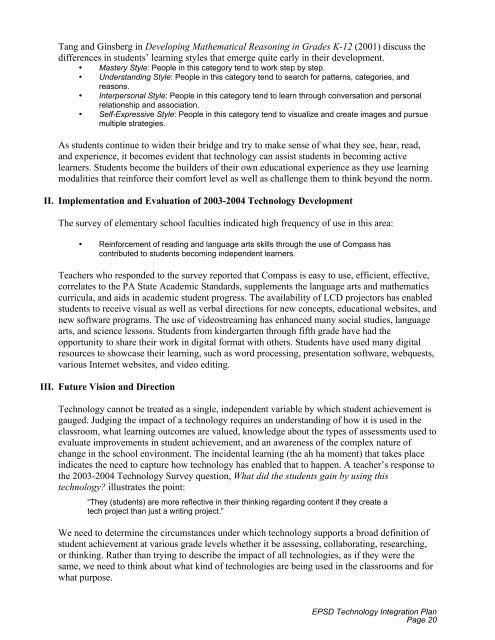EPSDtechintplan2004
EPSDtechintplan2004
EPSDtechintplan2004
You also want an ePaper? Increase the reach of your titles
YUMPU automatically turns print PDFs into web optimized ePapers that Google loves.
Tang and Ginsberg in Developing Mathematical Reasoning in Grades K-12 (2001) discuss the<br />
differences in students’ learning styles that emerge quite early in their development.<br />
• Mastery Style: People in this category tend to work step by step.<br />
• Understanding Style: People in this category tend to search for patterns, categories, and<br />
reasons.<br />
• Interpersonal Style: People in this category tend to learn through conversation and personal<br />
relationship and association.<br />
• Self-Expressive Style: People in this category tend to visualize and create images and pursue<br />
multiple strategies.<br />
As students continue to widen their bridge and try to make sense of what they see, hear, read,<br />
and experience, it becomes evident that technology can assist students in becoming active<br />
learners. Students become the builders of their own educational experience as they use learning<br />
modalities that reinforce their comfort level as well as challenge them to think beyond the norm.<br />
II. Implementation and Evaluation of 2003-2004 Technology Development<br />
The survey of elementary school faculties indicated high frequency of use in this area:<br />
• Reinforcement of reading and language arts skills through the use of Compass has<br />
contributed to students becoming independent learners.<br />
Teachers who responded to the survey reported that Compass is easy to use, efficient, effective,<br />
correlates to the PA State Academic Standards, supplements the language arts and mathematics<br />
curricula, and aids in academic student progress. The availability of LCD projectors has enabled<br />
students to receive visual as well as verbal directions for new concepts, educational websites, and<br />
new software programs. The use of videostreaming has enhanced many social studies, language<br />
arts, and science lessons. Students from kindergarten through fifth grade have had the<br />
opportunity to share their work in digital format with others. Students have used many digital<br />
resources to showcase their learning, such as word processing, presentation software, webquests,<br />
various Internet websites, and video editing.<br />
III. Future Vision and Direction<br />
Technology cannot be treated as a single, independent variable by which student achievement is<br />
gauged. Judging the impact of a technology requires an understanding of how it is used in the<br />
classroom, what learning outcomes are valued, knowledge about the types of assessments used to<br />
evaluate improvements in student achievement, and an awareness of the complex nature of<br />
change in the school environment. The incidental learning (the ah ha moment) that takes place<br />
indicates the need to capture how technology has enabled that to happen. A teacher’s response to<br />
the 2003-2004 Technology Survey question, What did the students gain by using this<br />
technology? illustrates the point:<br />
“They (students) are more reflective in their thinking regarding content if they create a<br />
tech project than just a writing project.”<br />
We need to determine the circumstances under which technology supports a broad definition of<br />
student achievement at various grade levels whether it be assessing, collaborating, researching,<br />
or thinking. Rather than trying to describe the impact of all technologies, as if they were the<br />
same, we need to think about what kind of technologies are being used in the classrooms and for<br />
what purpose.<br />
EPSD Technology Integration Plan<br />
Page 20


